“Your chances of achieving the American Dream are almost two times higher … if you are growing up in Canada than in the United States,” said Harvard’s Raj Chetty at a Center on Children and Families (CCF) event held on Monday. Chetty, the Bloomberg Professor of Economics and a leading scholar on opportunity and intergenerational mobility, presented his latest research on how where one grows up has a huge impact on success later in life. In his presentation, Prof. Chetty focused not on international comparisons, but on variations within the United States, where, he said, upward mobility varies even more. Chetty and colleagues calculated upward mobility for every metro and rural area in the United States.
The heat map below shows the chances that a child born in the bottom fifth of the income distribution in that particular place will reach the top fifth later in life:

Why does upward mobility vary so much across places? Prof. Chetty explored two explanations: (1) that people are different, and (2) that places themselves have a causal effect. Prof. Chetty showed an example of how, in the Washington, DC-Baltimore region, children growing up in low-income (25th percentile) families have different social mobility outcomes depending on where they are growing up. In the map below, for example, a child growing up in a low-income family in Fairfax County will earn 15.4 percent more than the average child, while those children in the darker shaded areas will experience lower earnings than the average.

Download Prof. Chetty’s entire presentation here and watch the full event video below, moderated by Senior Fellow Richard Reeves, policy director of CCF, who, with Allegra Pocinki, wrote an analysis of the event and solutions presented there: “Space, place, race: Six policies to improve social mobility.”
Visit the event’s web page for more information.



Commentary
These maps from Raj Chetty show that where children grow up has a major impact on their lifetime earnings
June 2, 2015